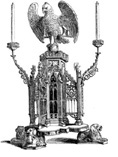
Pray the Rosary
HOPE IN A HOPELESS WORLD
I went to a Rosary devotion a few nights ago, the first I have ever been to. It is held every Wednesday evening at the small chapel my family and I have been attending for the past year or so, a chapel where the indult Tridentine Mass is said. We stumbled upon this place after doing what I had sworn we would never do subsequent to our conversion to Catholicism: church shopping. But the parishes we went to early in our conversion were so awful, and the priests taught things contrary to the Faith so frequently, that shop we did, and now here we are.
The fire marshal will allow 160 people to be seated in the chapel; my experience is that it’s closer to that number than not on any given Sunday. The fittings are simple: wooden pews, wrought-iron altar rail, a tasteful, modestly carved wooden altar with the requisite marble component. Statues of St. Mary, St. Joseph, and St. Michael guard the altar and the Tabernacle — and the Tabernacle is smack in the middle of it all, right under the golden crucifix and beneath the six high candlesticks, so that you know where the focus of the Mass is and you’re never confused about where to make your genuflection.
The Tridentine Mass itself wasn’t totally alien; both my wife and I come from an Episcopal Church background and are used to formal liturgy, altar rails, and kneeling for Communion. We are used to the idea that the space between the railing and the altar is a holy place; you don’t go mucking about in there just for the heck of it whether you’re a priest, altar boy, or layman. Following along with the liturgy really hasn’t been the problem it is often advertised to be. There are lots of simple outlines available: The one put out by The Coalition in Support of Ecclesia Dei costs only a couple of bucks, and has the Latin and English side by side, and little line drawings of what the priest is doing, along with marginal comments on what’s going on, as well as what you should be doing (kneeling, standing, not receiving Communion if you’re not in a state of grace, etc.). Follow the booklet and the Mass closely, and in a couple of weeks you’ll have the swing of it, and you’ll have learned a bit of theology in the meantime. It’s not that difficult.
The greatest challenge in our family’s adaptation to the Tridentine Mass has been managing our four small children. They’re not badly behaved, as far as six-year, four-year, two-year, and two-month-old children go; it’s just that they’re, well, children, and the four-year-old’s question, “Is it over yet?” sticks out ever so much more during the silent Tridentine consecration than it ever did in the Novus Ordo liturgy. “This too,” I tell myself, “is but a season.”
My family being away for a few days, I am alone, and come home to a house unchanged from how I left it in the morning. So, I decide to go to the Wednesday-evening Rosary at the chapel.
You May Also Enjoy
Karl Barth, speaking for classical Reformation theology, wrote in his Church Dogmatics: “In the doctrine…
Today is January 7, 1990, and I am in Lourdes. A few weeks ago I…
She who shared the highs in our Lord's life shared as well in His rejection. There is a striking similarity between the indignities suffered by Mother and Son.

